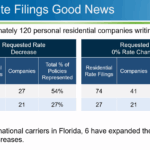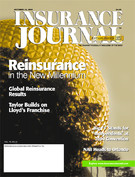Recently, my wife and I invited a number of the college students we teach over to our house. The center of attention for the party was the 12-foot wide, 120-foot long ‘slip-and-slide’ constructed down the hill of our backyard.
There were bodies (mine included) surfing, slipping, and sliding down that thing all afternoon until dark. My soreness has finally subsided to a point where now typing is no longer painful. Aside from ‘Are you nuts?’ the most frequently asked question we got after this escapade was ‘Did you get pictures?’
Similarly, what’s interesting is that with the increasing power and functionality of digital cameras coupled with the dropping price, insurance professionals are getting asked the same question. However, getting the most out of a digital camera means taking a look at a number of factors.
How do I use this thing?
There are a lot of digital cameras on the market offering a number of features at a number of prices. But before you go out and buy one, you need to really ask yourself how you plan to use it. If you plan to only use it to put pictures of your agency and staff on the web then you can get off cheap with a camera that shoots 640 x 480 pixel pictures that can be uploaded using a USB or serial cable into your computer.
Many agents, though, are now using the digital camera to document claims. If the pictures are only going to be viewed online, then a sub-1-megapixel camera (cameras shooting pictures of 1150 x 860 pixels or less) should be sufficient. For those that need hard copies, you’ll want at least a 1-megapixel camera, and if you plan to print pictures bigger than 5 x 7 inches, I’d look for at least a 2-megapixel camera.
If you plan to shoot photos for claims and the like, then you also need to think about the storage. Unfortunately, digital camera manufacturers are about as standard on picture storage as the insurance industry is on SEMCI. They all offer it at high levels, but it all depends on who you go with. For example, Sony offers two digital camera lines—the Mavica and the CyberShot. Depending on the model of Mavica, pictures can either be stored on 1.44 MB floppy disk or 158 MB mini-CDs. The CyberShot utilizes a ‘memory stick,’ which is the size of a stick of gum and can hold a number of pictures. Other brands such as Kodak and Nikon use Compact FLASH cards in some of their models.
Most 1+ megapixel cameras offer two or three quality levels for pictures. Pictures will be stored in either the .JPEG format or in the more memory-hogging .TIFF format. Usually you’ll get more pictures using the .JPEG format as there is greater compression and sometimes less resolution. But if you are looking for detail, then the .TIFF is the way to go.
The reason I stress the storage capabilities and the memory is that these two factors also set the boundaries as to how the camera can be used. If you need high quality shots, you will probably not be e-mailing the 8-10 MB .TIFF file. Plus, you’ll need to have your laptop nearby to download the shots should you need more than one. Or you’ll want to get a camera that allows removable media like the floppies, mini-discs or memory sticks.
A businessman I work with who shoots high-end pictures for insurance purposes uses a camera with a 128 MB FLASH card and then later uploads the shots on his computer back at the office using a FLASH card reader. This way he can focus on taking shots and not worry about having to upload after every shot.
Are you getting one?
Once you get a feel for how you want to use the camera then it is time to look at the camera itself. Prices vary between brands, pixel resolutions and expandability. Here are some things to make sure you remember when looking at cameras.
Get a camera that has some sort of removable media so you’re not tied to a computer. And while you’re at it, I’d make sure it offers you at least two picture quality levels. An agent friend of mine uses low quality to send pictures to one of his carriers to allow the rep he works with to get a quick picture of what he’s talking about or dealing with. Another agent I know uses the high-quality setting in order to shoot pictures of insured items and then prints copies out on photo paper from an inkjet printer—one for his files and one for the customer.
Get a camera that uses regular batteries. They may drain faster but you won’t ever be in a bind should they go out and then you have to wait for the battery pack to recharge. Also make sure it comes with an AC adapter. I use the adapter any time I’m uploading onto my computer or sorting through photos on the view finder for an extended period of time. If you really want to save on batteries, look for a camera that allows you to zoom and view the shot through the eyepiece and not through the LCD viewer.
Unless you want the bare minimum or the ultra high-end, most insurance professionals or agency owners will probably be looking at a camera with 1-2 megapixel resolution, a built-in flash, and pretty good zoom capabilities somewhere between $400-$900, depending on the media type and modifications/extras. A nice add-on is a voice-recorded memo function that allows you to annotate the photos you take.
Say “cheese”
Is a digital camera really a necessity? No. But they do say a picture is worth a thousand words. You’ll find more and more insurance professionals taking pictures for their files or to e-mail to a carrier. Instead of a Polaroid that may get lost, it’s much easier to shoot an ‘e-photo’ and place it in a customer’s file that can be accessed or shared by agency and company.
Part of reducing the error that occurs in processing insurance information is the ability to communicate effectively. So when two or more people can actually see what is being discussed, the possibility for error is greatly reduced, if not eliminated.
However, I will admit that there are times when you really don’t want to have a camera around. For me, I think sliding down 120 feet of plastic, flailing like a dying cockroach, is probably best left up to the imagination.
Technocracy is a regular column designed to examine and explain new technology and how it applies to the insurance industry. Readers are encouraged to e-mail questions or comments to John Chivvis at ijwest@insurancejournal.com.
Was this article valuable?
Here are more articles you may enjoy.


 Slide’s Exec Pay Leads to Questions About Florida Citizens’ Rate Model
Slide’s Exec Pay Leads to Questions About Florida Citizens’ Rate Model  Two More Insurers Enter Florida Market as Hurricane Season Warms Up
Two More Insurers Enter Florida Market as Hurricane Season Warms Up  What to Watch: The Trends for P/C Insurance in 2025 So Far
What to Watch: The Trends for P/C Insurance in 2025 So Far  Hedge Fund Strategy Built on Catastrophes Taps a Hot New Trend – Parametrics
Hedge Fund Strategy Built on Catastrophes Taps a Hot New Trend – Parametrics 


